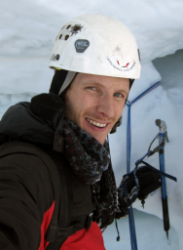Gordon Bromley
Address: 123A Geography, National University of Ireland, Galway
Geology and Archaeology Professor, NUI Galway
The ‘How’ and ‘Why’ of climate change, as well as its impacts on society and ecosystems, are the broad foci of my research interests. Of particular concern to me is the tropics, a region lying at the heart of Earth’s climate system and which is home to the majority of all life. The tropics play a key role in ice ages and the global transmission of abrupt climate signals. Thus, deciphering both the timing and true nature of past events at low latitudes is fundamental to our understanding of the role of the tropics in climate. In conjunction with colleagues at UMaine, Dartmouth College, Lamont-Doherty Earth Observatory, Pacific Lutheran University, Berkeley Geochronology Center, the Escuela de Ingenieria de Antioquia (Colombia) and the Departamento de Geociencias y Medio Ambiente at Universidad Nacional de Colombia, I am employing geomorphic mapping and surface-exposure/radiocarbon dating to resolve the timing of late-Quaternary glacial events, such as the last glacial maximum and late-glacial reversals. This evolving project also involves snowline reconstructions and palaeoecological studies, as a measure of the magnitude past climate events, and deciphering the human record of settlement and adaptation in the high Andes of South America.

As a natural extension of these palaeoclimate investigations, and bridging the gap between past and future climate change, I am developing research aimed at determining the glacial contribution to regional hydrology in arid tropical regions. This multi-institutional, international project involves Brigham Young University, U.C. Santa Cruz, and Berkeley Geochronology Center, as well as Peruvian collaborators in Arequipa, and combines a glaciologic study of glaciers in southern Peru – where the prevailing climate is arid -, chronologic constraint of past meltwater variability, and direct measurement of modern meltwater discharge in the Peruvian Andes. Additionally, a further tropics-based investigation seeks to understand the relationship between rapid deglaciation and volcanism. This work, involving colleagues at Michigan Technological University, will employ surface-exposure dating of glacial and volcanic landforms in addition to micro-morphometric analysis of erupted mineral grains such as quartz (in dacite) and pyroxene (dacite and andesite). At the other end of the latitudinal range, I am involved in reconstructing the deglacial history of the Ross Sea Embayment, Antarctica. As part of projects in the southern Transantarctic Mountains, I have been using glacial geology to help determine the former configuration of the West Antarctic Ice Sheet and the potential contribution of Antarctica to postglacial sea level rise. My involvement with this work continues in collaboration with Brenda Hall (U. Maine) and John Stone (U. Washington). Additionally, with Greg Balco (Berkeley Geochronology Center) I am conducting new NSF-funded research into the long-term stability (or otherwise!) of the East Antarctic Ice Sheet, using the geologic record of glaciation from the interior Transantarctic Mountains (see http://wabi.tv/2015/09/28/umaine-research-professor-headed-to-antarctica/). Meanwhile, exciting forays into abrupt climte change are taking my research into the North Atlantic region, where rapid – yet poorly understood – switches in oceanic and atmospheric circulation have wrought havoc on a disturbingly human timescales.

Throughout my work, cosmogenic surface-exposure dating constitutes a vital tool for constructing precise and accurate geologic chronologies. After completing my doctorate at Maine in 2010, I held a postdoctoral fellowship at Lamont-Doherty Earth Observatory, New York, where I focused on the use of cosmogenic helium in surface-exposure dating. I continue to apply surface-exposure dating in my tropical work, as well as for palaeoclimate applications in Great Britain, Antarctica, and New England.


